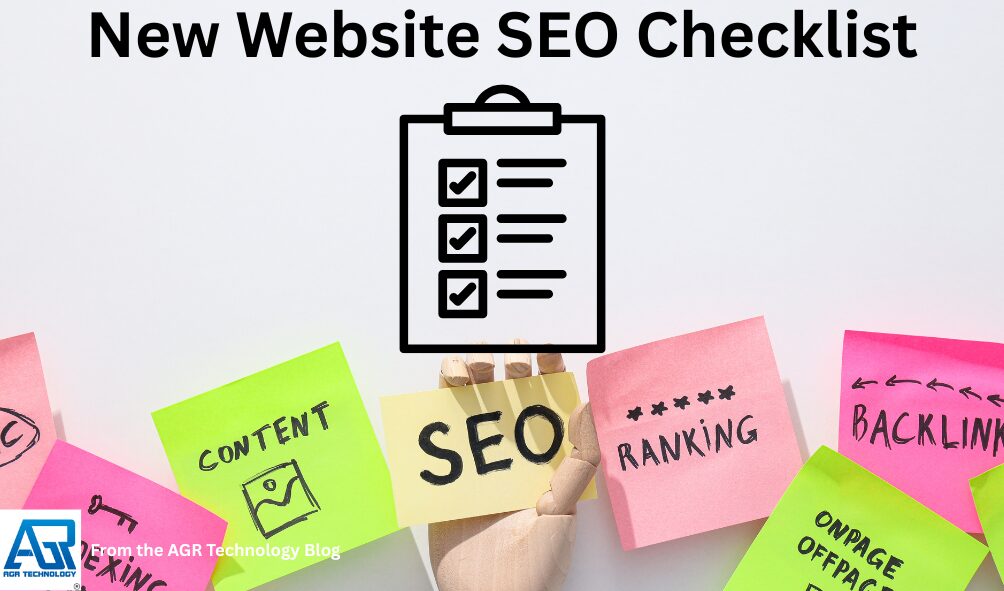Launching a new website is exciting, and risky. Miss a few technical SEO basics and you can bury great content before it has a chance. We’ve pulled together a practical new website SEO checklist based on what we carry out for clients at AGR Technology. It’s clear, actionable, and built to help you avoid common SEO pitfalls while setting you up for sustainable growth. If you want us to handle the heavy lifting, we can audit, carry out, and track everything for you.
Need help with SEO for your business? Contact AGR Technology to see how we can help
Set Up Technical Foundations

Secure HTTPS, Preferred Domain, And URL Consistency
Security and consistency are non‑negotiable.
- Install a valid SSL/TLS certificate and force HTTPS sitewide (301 redirects from HTTP).
- Choose a preferred domain (www vs non‑www) and redirect the other to it.
- Enforce one version of each URL (no trailing slash duplicates, lowercase, no mixed casing).
- Block test/staging environments from indexing and protect them with HTTP auth.
Why it matters: Mixed protocols and inconsistent hostnames create duplicate content and split link equity.
Ensure Crawlability: Robots.txt, Sitemap.xml, Canonicals, And Noindex
Give search engines a clean path.
- Robots.txt: allow essential paths, disallow admin/carts, and reference your XML sitemap.
- XML sitemaps: submit primary and image/video sitemaps: keep file sizes manageable and URLs 200‑status only.
- Canonical tags: set self‑referencing canonicals for each indexable page: point variants (e.g., sort parameters) to the canonical.
- Meta robots: use noindex for thin/tag pages, internal search, or gated content. Avoid noindex on pages with valuable backlinks.
- Pagination: use strong internal links and canonicalisation: ensure unique H1/title for paginated sets.
Design Clean Architecture And Navigation
Plan for both users and crawl budget.
- Keep key pages within 3 clicks from the homepage.
- Logical hierarchy: Home → Category (hub) → Subcategory → Detail.
- Use breadcrumb navigation and include it in your templates.
- Build hub pages for topic clusters to consolidate relevance and distribute PageRank.
- Avoid orphan pages: every page should have at least one internal link.
Optimize Speed And Core Web Vitals
Performance is table stakes for rankings and conversions.
- Targets: LCP < 2.5s, INP < 200ms, CLS < 0.1 (per Google’s Core Web Vitals guidance).
- Optimise images (next‑gen formats like WebP/AVIF, proper dimensions, lazy‑loading).
- Minify CSS/JS, defer non‑critical JS, inline critical CSS.
- Use HTTP/2 or HTTP/3, enable server‑level caching, and configure a CDN.
- Preload key assets (hero image, primary font) and reduce third‑party scripts.
Need a quick technical audit? We can run a full crawl, fix indexation issues, and tune performance across templates.
Build Your Keyword Strategy And Site Structure

Define Topic Clusters And Primary Keywords
Start with problems your audience actually searches for.
- Research primary keywords and long‑tails with tools (Search Console, Keyword Planner, Ahrefs, Semrush).
- Group queries into topic clusters (e.g., “accounting software” → pricing, integrations, tutorials, comparisons).
- Prioritise by intent and business value: transactional and high‑intent informational pages come first.
Map Search Intent And Keywords To Pages
Every page needs a clear job.
- Match page type to intent:
- Informational → guides, FAQs.
- Commercial → comparison, use cases, features.
- Transactional → product/service pages.
- One primary keyword per page: support with semantically related terms (entities, synonyms, questions).
- Avoid cannibalisation: if two pages target the same term, merge or differentiate them.
Plan URL Structure, Breadcrumbs, And Hubs
Make structure predictable and scalable.
- Human‑readable, short URLs: /category/subcategory/keyword/ (no dates for evergreen pages).
- Include keywords where natural: avoid stop‑words where not needed.
- Standardise breadcrumbs and mirror your IA.
- Create hub pages that link to child content and related resources to build topical authority.
If you’d like a done‑for‑you keyword map and site blueprint, AGR Technology can produce it and align it with your CMS and dev stack.
Optimize On-Page Elements
Craft SEO-Friendly Titles And Meta Descriptions
Earn the click with clarity.
- Title tags: lead with the primary keyword, keep to ~50–60 chars, include value (benefit, feature, or USP).
- Meta descriptions: ~120–155 chars, reflect search intent, use natural CTAs: avoid duplication.
- Use unique titles/metas across templates (category, product, service, blog).
Use Clear Header Hierarchy And Readable Copy
Help scanners and skimmers.
- One H1 per page: logical H2/H3 structure underneath.
- Front‑load key info in the first 100–150 words.
- Write in short paragraphs, use bullets, and keep Flesch readability in mind.
- Cover related entities and FAQs so your page can win rich results.
Strengthen Internal Linking And Anchor Text
Pass relevance and authority where it counts.
- Add contextual internal links from high‑authority pages to new or strategic pages.
- Use descriptive, natural anchor text (avoid over‑optimisation).
- Build “next steps” links: hubs → subpages, and subpages → hubs.
- Regularly audit for broken links and redirect chains.
Improve Images: Filenames, Alt Text, And Compression
Make media work for SEO and accessibility.
- Descriptive filenames (product‑name‑size‑colour.webp).
- Alt text that states what the image shows and why it’s relevant.
- Compress with lossless settings where quality matters: serve responsive srcset sizes.
- Add captions where helpful: index only images that add value.
Implement Structured Data And Media Enhancements
Add Core Schemas By Page Type
Give search engines explicit context.
- Organization, WebSite (with SearchAction), and BreadcrumbList as a baseline.
- Service/Product pages: Product or Service, plus Offer, AggregateRating when applicable.
- Articles/Guides: Article/BlogPosting with author, datePublished, and image.
- FAQs: FAQPage for genuine Q&A sections.
- Local SEO: LocalBusiness with NAP consistency and opening hours.
Enable Breadcrumb And Organization Markup
Improve sitelinks and brand clarity.
- Carry out JSON‑LD for breadcrumbs tied to your IA.
- Use Organization schema with logo, sameAs links (LinkedIn, Facebook, X), and contact options.
- For multi‑location businesses, add distinct LocalBusiness entities per location.
Set Open Graph And Twitter Cards For Sharing
Control how your pages look when shared.
- og:title, og:description, og:image (1200×630), og:url, and og:type.
- Twitter Card summary_large_image for better CTR on social.
- Use unique images per key page: test with Facebook Sharing Debugger and Twitter Card Validator.
If you’d like us to carry out schema markup correctly across templates, we can ship validated JSON‑LD and test with Google’s Rich Results tool.
Launch, Tracking, And Ongoing Optimization
Configure GA4, Key Conversions, And Search Console
Measure what matters from day one.
- GA4: set data streams, enhanced measurement, internal traffic filters.
- Define conversions: form submits, phone clicks, checkout steps, trials, and key micro‑conversions.
- Link GA4 to Google Ads (if applicable) and enable cross‑domain tracking where needed.
- Google Search Console: verify all properties (domain + http/https variants), set preferred settings, and geo‑targeting if relevant.
Submit Sitemaps, Inspect URLs, And Set Redirects
Ensure a clean launch.
- Submit XML sitemaps in GSC: use the URL Inspection tool to request indexing on priority pages.
- Carry out 301 redirects from legacy URLs to new equivalents: avoid mass 404s.
- Custom 404 page with helpful links and search.
- Post‑launch crawl with Screaming Frog or Sitebulb to catch errors early.
Monitor Rankings, CTR, And Core Engagement Metrics
Iterate based on data, not guesses.
- Track target keywords by page and device: watch for cannibalisation.
- In GSC, monitor impressions, CTR, average position, and coverage issues.
- In GA4, review landing page performance: engagement rate, INP, and conversion rate.
- Use A/B testing for titles/meta descriptions on high‑impression, low‑CTR pages.
Earn Links And Build Trust Signals (E-E-A-T, Reviews, Local)
Authority compounds over time.
- Publish expert‑led content with named authors and clear credentials.
- Acquire relevant backlinks via digital PR, partnerships, and high‑quality directories.
- Collect and respond to reviews (Google Business Profile, industry platforms).
- Maintain consistent NAP, add services, and post updates on your GBP.
- Add trust pages: About, Team, Editorial Policy, Privacy, Terms, and Contact with real addresses.
Want a managed SEO service? AGR Technology can handle monitoring, reporting, and continuous optimisation so you stay ahead while we sweat the details.
Conclusion
A new website only gets one launch. When the technical base, keyword strategy, on‑page work, schema, and analytics are set up properly, growth comes faster and with fewer surprises. If you’d like a second set of eyes, or a hands‑on team, to carry out this new website SEO checklist, reach out to AGR Technology. We’ll review your site, prioritise the fixes with the biggest impact, and set up tracking so you can see results clearly.
Next step: Request a quick SEO health check from us, and we’ll send you a free report to identify opportunities for growth
Frequently Asked Questions
What should be included in a New Website SEO Checklist at launch?
A solid New Website SEO Checklist covers technical foundations (HTTPS, canonical URLs, robots.txt, sitemaps), clean IA with breadcrumbs, Core Web Vitals performance, keyword mapping and hub pages, on‑page elements (titles, metas, headers), structured data, analytics setup (GA4, GSC), redirects, and post‑launch monitoring for issues and opportunities.
How do I ensure Google can crawl and index a new site correctly?
Provide a clear crawl path: allow essential sections in robots.txt, submit XML sitemaps in Google Search Console, set self‑referencing canonicals, and apply noindex to thin, internal search, or staging pages. Fix duplicate URL versions with redirects, avoid orphan pages, and use internal links to surface priority content.
What’s the best way to map keywords and search intent to pages on a New Website SEO Checklist?
Group topics into clusters, then assign one primary keyword per page with related entities and questions. Match page type to intent: informational guides/FAQs, commercial comparisons/use cases, transactional product or service pages. Prevent cannibalization by merging or differentiating overlapping pages, and reflect structure in URLs and breadcrumbs.
Which structured data should a new website implement first?
Start with Organization, WebSite (SearchAction), and BreadcrumbList for global context. Add page‑type schemas: Product/Service with Offer and ratings, Article/BlogPosting for guides, FAQPage for genuine Q&A, and LocalBusiness for location pages. Use JSON‑LD, validate with Google’s Rich Results test, and ensure markup mirrors visible content.
How long does SEO take for a new website to show results?
Most new sites see meaningful traction in 3–6 months, depending on competition, content depth, technical health, and link acquisition. Faster indexing comes from clean sitemaps, internal links, and fresh content. Track progress via GA4 and Search Console, iterate titles/metas for CTR, and refine pages based on data.
Related pages:
SEO & Linkbuilding Services For In-house Marketing Teams

Alessio Rigoli is the founder of AGR Technology and got his start working in the IT space originally in Education and then in the private sector helping businesses in various industries. Alessio maintains the blog and is interested in a number of different topics emerging and current such as Digital marketing, Software development, Cryptocurrency/Blockchain, Cyber security, Linux and more.
Alessio Rigoli, AGR Technology
![logo-new-23[1] logo-new-23[1]](https://agrtech.com.au/wp-content/uploads/elementor/thumbs/logo-new-231-qad2sqbr9f0wlvza81xod18hkirbk9apc0elfhpco4.png)
